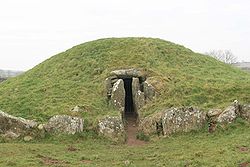
Bryn Celli Ddu
Encyclopedia


Bryn Celli Ddu is a prehistoric site on the Welsh
Wales
Wales is a country that is part of the United Kingdom and the island of Great Britain, bordered by England to its east and the Atlantic Ocean and Irish Sea to its west. It has a population of three million, and a total area of 20,779 km²...
island of Anglesey
Anglesey
Anglesey , also known by its Welsh name Ynys Môn , is an island and, as Isle of Anglesey, a county off the north west coast of Wales...
located near Llanddaniel Fab
Llanddaniel Fab
Llanddaniel Fab is a village in the ward of Llanidan, southern Anglesey, Wales.It is near the prehistoric monument of Bryn Celli Ddu which was constructed in the late neolithic period....
. Its name
Welsh placenames
The placenames of Wales derive in most cases from the Welsh language, but have also been influenced by linguistic contact with the Romans, Anglo-Saxons, Vikings, Anglo-Normans and modern English...
means 'the mound in the dark grove'. It was plundered in 1699 and archaeologically excavated between 1928 and 1929.
During the Neolithic
Neolithic
The Neolithic Age, Era, or Period, or New Stone Age, was a period in the development of human technology, beginning about 9500 BC in some parts of the Middle East, and later in other parts of the world. It is traditionally considered as the last part of the Stone Age...
period a stone circle
Stone circle
A stone circle is a monument of standing stones arranged in a circle. Such monuments have been constructed across the world throughout history for many different reasons....
and henge
Henge
There are three related types of Neolithic earthwork which are all sometimes loosely called henges. The essential characteristic of all three types is that they feature a ring bank and ditch but with the ditch inside the bank rather than outside...
stood at the site. An area of burnt material containing a small human bone from the ear, covered with a flat stone, was recovered.
The stones were removed in the early Bronze Age
Bronze Age
The Bronze Age is a period characterized by the use of copper and its alloy bronze as the chief hard materials in the manufacture of some implements and weapons. Chronologically, it stands between the Stone Age and Iron Age...
when an archetypal passage grave
Passage grave
thumb|250px|right|A simple passage tomb in [[Carrowmore]] near [[Sligo]] in IrelandA passage grave or passage tomb consists of a narrow passage made of large stones and one or multiple burial chambers covered in earth or stone. Megaliths are usually used in the construction of passage tombs, which...
was built over the top of the centre of the henge. A carved stone with a twisting, serpentine design stood in the burial chamber. It has since been moved to the National Museum of Wales and replaced with a replica standing outside. An earth barrow
Tumulus
A tumulus is a mound of earth and stones raised over a grave or graves. Tumuli are also known as barrows, burial mounds, Hügelgrab or kurgans, and can be found throughout much of the world. A tumulus composed largely or entirely of stones is usually referred to as a cairn...
covering the grave is a twentieth century restoration; the original was probably much bigger.
Norman Lockyer, who in 1906 published the first systematic study of megalithic astronomy, had argued that Bryn Celli Ddu marked the summer solstice
Solstice
A solstice is an astronomical event that happens twice each year when the Sun's apparent position in the sky, as viewed from Earth, reaches its northernmost or southernmost extremes...
. This was ridiculed at the time, but research by Christopher Knight and Robert Lomas in 1997- 98 showed this to be true. Knight and Lomas also claimed year round alignments allowed the site to be used as an agricultural calendar. Steve Burrow, curator of Neolithic
Neolithic
The Neolithic Age, Era, or Period, or New Stone Age, was a period in the development of human technology, beginning about 9500 BC in some parts of the Middle East, and later in other parts of the world. It is traditionally considered as the last part of the Stone Age...
archaeology at Amgueddfa Cymru (National Museum of Wales) has more recently supported the case for summer solstice alignment. This alignment links Bryn Celli Ddu to a handful of other sites, including Maes Howe and Newgrange
Newgrange
Newgrange is a prehistoric monument located in County Meath, on the eastern side of Ireland, about one kilometre north of the River Boyne. It was built around 3200 BC , during the Neolithic period...
, both of which point to the midwinter solstice
Solstice
A solstice is an astronomical event that happens twice each year when the Sun's apparent position in the sky, as viewed from Earth, reaches its northernmost or southernmost extremes...
. It has also been suggested that a feature similar to the 'lightbox' at Newgrange may be matched at Bryn Celli Ddu (Pitts, 2006).
A row of five posthole
Posthole
In archaeology a posthole is a cut feature used to hold a surface timber or stone. They are usually much deeper than they are wide although truncation may not make this apparent....
s previously thought to have been contemporary with the tomb (c. 3000 BC) have recently been proven to be much earlier. Early results from a radiocarbon programme date pine charcoal from two of the pits to the Mesolithic
Mesolithic
The Mesolithic is an archaeological concept used to refer to certain groups of archaeological cultures defined as falling between the Paleolithic and the Neolithic....
(Pitts, 2006).

